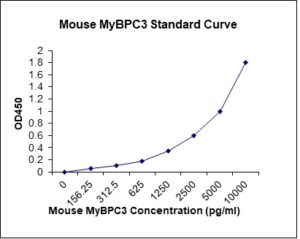Nori Mouse MyBPC3 ELISA Kit
$461.00 – $832.00
This ELISA kit is for quantification of MyBPC3 in mouse. This is a quick ELISA assay that reduces time to 50% compared to the conventional method, and the entire assay only takes 3 hours. This assay employs the quantitative sandwich enzyme immunoassay technique and uses biotin-streptavidin chemistry to improve the performance of the assays. An antibody specific for MyBPC3 has been pre-coated onto a microplate. Standards and samples are pipetted into the wells and any MyBPC3 present is bound by the immobilized antibody. After washing away any unbound substances, a detection antibody specific for MyBPC3 is added to the wells. Following wash to remove any unbound antibody reagent, a detection reagent is added. After intensive wash a substrate solution is added to the wells and color develops in proportion to the amount of MyBPC3 bound in the initial step. The color development is stopped, and the intensity of the color is measured.
Alternative names for MyBPC3: myosin-binding protein C, cardiac-type (MyBPC3 or cMyBP-C)
This product is for Laboratory Research Use Only not for diagnostic and therapeutic purposes or any other purposes.
- Description
- How Elisa Works
- Product Citation (0)
- Reviews (0)
Description
Nori Mouse MyBPC3 ELISA Kit Summary
Alternative names for MyBPC3: myosin-binding protein C, cardiac-type (MyBPC3 or cMyBP-C)
| Assay Type | Solid Phase Sandwich ELISA |
| Format | 96-well Microplate or 96-Well Strip Microplate |
| Method of Detection | Colorimetric |
| Number of Targets Detected | 1 |
| Target Antigen Accession Number | O70468 |
| Assay Length | 3 hours |
| Quantitative/Semiquantitative | Quantitative |
| Sample Type | Plasma, Serum, Cell Culture, Urine, Cell/Tissue Lysates, Synovial Fluid, BAL, |
| Recommended Sample Dilution (Plasma/Serum) | No dilution for sample <ULOQ; sufficient dilution for samples >ULOQ |
| Sensitivity | 30 pg/mL |
| Detection Range | 0.156-10 ng/mL |
| Specificity | Mouse MyBPC3 |
| Cross-Reactivity | < 0.5% cross-reactivity observed with available related molecules, < 50% cross-species reactivity observed with species tested. |
| Interference | No significant interference observed with available related molecules |
| Storage/Stability | 4 ºC for up to 6 months |
| Usage | For Laboratory Research Use Only. Not for diagnostic or therapeutic use. |
| Additional Notes | The kit allows for use in multiple experiments. |
Standard Curve
Kit Components
1. Pre-coated 96-well Microplate
2. Biotinylated Detection Antibody
3. Streptavidin-HRP Conjugate
4. Lyophilized Standards
5. TMB One-Step Substrate
6. Stop Solution
7. 20 x PBS
8. Assay Buffer
Other Materials Required but not Provided:
1. Microplate Reader capable of measuring absorption at 450 nm
2. Log-log graph paper or computer and software for ELISA data analysis
3. Precision pipettes (1-1000 µl)
4. Multi-channel pipettes (300 µl)
5. Distilled or deionized water
Protocol Outline
1. Prepare all reagents, samples and standards as instructed in the datasheet.
2. Add 100 µl of Standard or samples to each well and incubate 1 h at RT.
3. Add 100 µl of Working Detection Antibody to each well and incubate 1 h at RT.
4. Add 100 µl of Working Streptavidin-HRP to each well and incubate 20 min at RT.
5. Add 100 µl of Substrate to each well and incubate 5-30 min at RT.
6. Add 50 µl of Stop Solution to each well and read at 450 nm immediately.
Background:
The myosin-binding protein C, cardiac-type (MyBPC3 or cMyBP-C) is a protein that in humans is encoded by the MYBPC3 gene.[1] This isoform is expressed exclusively in heart muscle during human and mouse development,[2] and is distinct from those expressed in slow skeletal muscle (MYBPC1) and fast skeletal muscle (MYBPC2). cMyBP-C is a 140.5 kDa protein composed of 1273 amino acids.[3] cMyBP-C is a myosin-associated protein that binds at 43 nm intervals along the myosin thick filament backbone, stretching for 200 nm on either side of the M-line within the crossbridge-bearing zone (C-region) of the A band in striated muscle. The approximate stoichiometry of cMyBP-C along the thick filament is 1 per 9-10 myosin molecules, or 37 cMyBP-C molecules per thick filament. In addition to myosin, cMyBP-C also binds titin and actin.[4] The cMyBP-C isoform expressed in cardiac muscle differs from those expressed in slow and fast skeletal muscle (MYBPC1 and MYBPC2, respectively) by three features: (1) an additional immunoglobulin (Ig)-like domain on the N-terminus, (2) a linker region between the second and third Ig domains, and (3) an additional loop in the sixth Ig domain.[5] cMyBP-C appears necessary for normal order, filament length and lattice spacing within the structure of the sarcomere.[6] cMyBP-C is not essential for sarcomere formation during embryogenesis, but is crucial for sarcomere organization and maintenance of normal cardiac function. Absence of cMyBP-C results in severe cardiac hypertrophy, increased heart-weight-to-body-weight-ratios, enlargement of ventricles, increased myofilament Ca2+ sensitivity and depressed diastolic and systolic function.[7] Histologically, MyBPC3-targeted knock-out hearts display structural rearrangements with cardiac myocyte disarray and increased interstitial fibrosis similar to patients with hypertrophic cardiomyopathy, without obvious alterations in shape or size of single cardiac myocytes, a loss of lateral alignment of adjacent myofibrils with their Z-lines misaligned.[7]
References
- Gautel M, et al. (1995). The EMBO Journal. 14 (9): 1952–60.
- Fougerousse F, et al. (1998). Circulation Research. 82 (1): 130–3.
- Carrier L, et al. (1997). Circulation Research. 80 (3): 427–34.
- Freiburg A, et al. (1996). European Journal of Biochemistry / FEBS. 235 (1–2): 317–23.
- Winegrad S (1999). Circulation Research. 84 (10): 1117–26.
- Colson BA, et al. (2007). Journal of Molecular Biology. 367 (1): 36–41.
- Harris SP, et al. (2002). Circulation Research. 90 (5): 594–601.
Be the first to review “Nori Mouse MyBPC3 ELISA Kit”
You must be logged in to post a review.




























Reviews
There are no reviews yet.